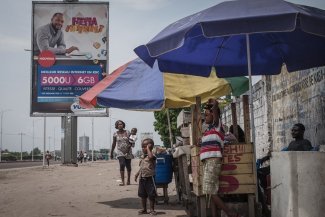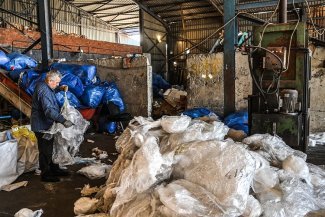
Belgrade Waterfront Residences, completed in July 2018, loom in the foreground, as construction continues on the Belgrade Waterfront Vista apartments just behind them. Photo taken on 19 October 2018.
The Belgrade Waterfront construction megaproject in central Belgrade attracted further controversy in mid-September when two workers fell to their deaths from the 22nd floor of a building under construction.
“The workers were lying on the ground without moving…[.] One of them had his thigh bones penetrating through his pants while the other had his legs bent to the side,” says a worker who was on site at the time of the accident and didn’t want to be named for fear of being fired.
“Immediately afterwards there was widespread panic. The men working illegally were sent away by their bosses and employers, as they didn’t have the proper paperwork.”
While offering his condolences five days later, Serbian president Aleksandar Vučić – who has been a leading champion of the Belgrade Waterfront mega-project ever since he announced it in 2012 – suggested that in the United States a window washer dies every ten seconds. An aide had evidently unearthed the bogus fact from the satirical news website The Onion.
But experts aren’t laughing, and say that conditions at construction sites in Serbia, including the Waterfront project, are often very poor.
“Obviously safety measures weren’t implemented, and this led to workers dying,” says Saša Torlaković, president of the Autonomous Union of Building and Construction Industry Workers. He says workers at that height should always be wearing safety harnesses.
The worker who spoke to Equal Times said conditions on the site where he works are very poor and safety measures are often ignored: “In short the conditions are catastrophic.”
The portable toilets are far away and hard to reach, so men often relieve themselves on the ground of the site. Workers often don’t wear safety gear such as earplugs.
“Pieces of concrete, stones, planks and other objects have fallen beside us without us even being aware of it,” the worker says, adding that his colleagues died because they were standing on a platform that wasn’t fully constructed.
Torlaković says that low wages have led to qualified construction workers going abroad, mostly to European Union countries that pay more, leaving behind low-skilled workers. The paltry salaries also cause men to work overtime and become exhausted.
“That’s what leads to accidents – they lose their concentration and get tired,” Torlaković says.
The worker confirmed that he and his colleagues work over 60 hours a week despite their contracts stipulating only 40 hours, and yet they still only earn €422 per month.
A Belgrade Waterfront representative declined to comment, but forwarded Equal Times a press release expressing condolences to the workers’ families and affirming the project’s commitment to the utmost safety standards:
“[The] company hires exclusively renowned contractors who adhere to the highest health and safety standards and all buildings pass through regular inspections that are conducted during the execution of construction works, in accordance with the law.”
On 3 October 2018, a Turkish worker was seriously injured after a fall at a Belgrade Waterfront site. Three months earlier, 80 illegally employed Turkish workers building a giant shopping centre at the Waterfront staged a protest at their embassy in Belgrade after not receiving their wages for two months.
Politicians have promoted Belgrade Waterfront as something that will support local workers, but Torlaković says this has not been the case.
“There’s a lot of illegal work and foreign workers, and we aren’t seeing workers returning to Serbia to work on the Belgrade Waterfront. They’re still going abroad.”
One of the main complaints against the Waterfront project is the lack of transparency from officials.
“Most information about the [implementation] of the project isn’t available to the general public,” says Mario Reljanović, a law professor specialising in labour issues at Union University in Belgrade.
Isidora Petrović, an activist with Ne da(vi)mo Beograd (Don’t Let Belgrade D(r)own), a group founded in opposition to the Waterfront project, is calling on the government to work in the public interest, not for investors.
“Authorities and institutions in Serbia serve as the PR service of investors, to whom they give parts of cities, but also the lives of workers who don’t have the means to earn money other than working in unsafe conditions.”
Contentious from the get-go
Belgrade Waterfront, touted as one of Europe’s largest urban renewal projects, will include amongst other things, the largest mall in the Balkans, an opera house, a 1.8 kilometre riverside promenade, eight hotels, and a 42-floor skyscraper with 220 luxury apartments. The mammoth project comprises a total construction area of 1.8 million square metres and will ultimately accommodate 14,000 residents within 6,000 units along the east bank of the Sava river in central Belgrade. The first phase is scheduled for completion by 2020, with the construction of two additional phases set to continue for several years afterward.
Belgrade Waterfront has been contentious from the get-go. There was no open bidding process, no international competition to choose architects and no public consultation.
In April 2015, the contract to fund and develop the project was simply awarded to Abu Dhabi-based investment firm Eagle Hills Properties. The firm’s chairman, Mohamed Alabbar, is also the founder of Emaar Properties, which built Dubai’s Burj Khalifa, the world’s tallest structure.
The split for both ownership and profits is 68 per cent for the developer and 32 per cent for the Serbian government.
The luxury condos, Belgrade’s most expensive, will reportedly cost as much as €7,000 per square metre, though the average salary in Serbia is only €422 per month, amongst the lowest in Europe.
Despite initial promises that Eagle Hills would invest a whopping €3 billion in the project, the actual figure appears to be drastically smaller – a €150 million initial investment, with additional loans up to €150 million. However, no one seems to be sure about all the details of the deal.
“The main contract isn’t a secret, but all other documents are: we don’t know who the subcontractors are, how many people they employ or similar data,” says economist Reljanović.
President Vučić’s pro-EU, populist, centre-right Progressive Party enjoys a firm hold over both parliament and Belgrade’s administration, and has dominated Serbia’s political institutions and media for years.
Critics accuse Vučić’s government of circumventing and changing the laws in order to fast-track the Belgrade Waterfront project. The government has also been accused of using a legal loophole to deem the project as being in the public interest, despite not satisfying the traditional requirements.
“Politicians treat Belgrade as loot,” says Dragoljub Bakić, a member of Serbia’s Academy of Architects.
The Waterfront deal has also been criticised for giving Eagle Hills “extra-territorial rights” – effectively free reign on the project, without having to adhere to Serbian laws.
“When the project came into the [implementation] phase, it became clear that many procedures, mechanisms and legally established competencies wouldn’t be respected,” says Reljanović.
“De facto extra-territoriality exists because not one of the [government] inspections have the power to [intervene] in the illegal stuff going on at the BW building sites…[.]The contract stipulates that Serbia will not adopt any legislation that could be against the interests of the BW company,” Reljanović explains.
“A complete urban failure”
Hundreds of homes and businesses have been moved from state-owned land to make way for the project, but some people refused, which paved the way for the most controversial incident related to Belgrade Waterfront.
On 24 April 2016 – election night in Serbia – dozens of masked men with baseball bats and bulldozers illegally demolished several buildings in the way of the project in the newly-rejuvenated Savamala neighbourhood, while tying up bystanders and seizing their mobile phones.
Police were called but instructed not to respond. Vučić himself said “the highest city officials” were involved (without naming any), and the ex-wife of then-mayor Siniša Mali (now finance minister)said he told her that he personally ordered it. Mali’s assistant declined to comment for Equal Times.
Tens of thousands of furious citizens took to the streets several times to protest in the largest demonstrations in Serbia in over a decade. Activist Petrović said they were soon targeted by the largely pro-government press as “traitors” and “mercenaries,” accused of being backed by foreign powers.
The only consequence of the illegal demolitions was the suspension and a plea bargain for the police shift commander on that night.
“One can easily conclude that the government [determined] that it’s enough to sacrifice someone lower on the scale instead of dealing with the organisers,” says Petrović. “The demolition required elaborate planning.”
Architect Bakić, who has 44 years of experience on projects in over a dozen countries, says the main problem with the project is that it lacks a coherent urban plan.
“This is a complete urban failure. It’s a mistake in every field – town planning, architecture, traffic, infrastructure, social [policy],” he tells Equal Times. “They’re building a separate town in the middle of the city.”
Bakić says the area where the project is being built is the most valuable in the city and should be open to the public.
“We architects and town planners want to make it the cultural centre of Belgrade once the city is rich enough – with libraries, universities, an opera house, music halls; with buildings no higher than three floors.”
Bakić also says Belgrade’s dilapidated infrastructure can’t support the Waterfront project, and traffic will be a huge problem in this city of 1.7 million people.
“Belgrade’s infrastructure is very old, neglected for many years, and now you build dwellings for 25,000 people in the middle of town,” he says, using a figure that includes office space for 12,000 in the project.
“Belgrade won’t survive this way. One day traffic will simply stop.”









